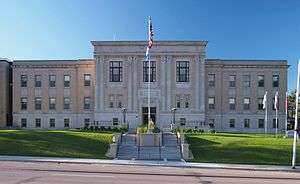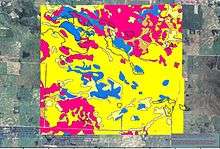Pope County, Minnesota
Pope County is a county in the U.S. state of Minnesota. As of the 2010 United States Census, the population was 10,995.[1] Its county seat is Glenwood.[2] The county was formed in 1862 and organized in 1866.
Pope County | |
|---|---|
 | |
 Location within the U.S. state of Minnesota | |
 Minnesota's location within the U.S. | |
| Coordinates: 45°35′N 95°27′W | |
| Country | |
| State | |
| Founded | February 20, 1862 (created) 1866 (organized) |
| Named for | John Pope |
| Seat | Glenwood |
| Largest city | Glenwood |
| Area | |
| • Total | 717 sq mi (1,860 km2) |
| • Land | 670 sq mi (1,700 km2) |
| • Water | 47 sq mi (120 km2) 6.6%% |
| Population (2010) | |
| • Total | 10,995 |
| • Estimate (2019) | 11,249 |
| • Density | 16.4/sq mi (6.3/km2) |
| Time zone | UTC−6 (Central) |
| • Summer (DST) | UTC−5 (CDT) |
| Congressional district | 7th |
| Website | www |
History
Pope County was identified by the state legislature in 1862[3] and named for John Pope, a Union Army general who had worked as a surveyor in the area.[4] Its organization was effected in 1866.
Pope County was the location of several protests against the CU Powerline in the 1970s.
Geography
The Chippewa River flows south through the county's western part. The Little Chippewa River flows south-southwest through its central part, discharging into the Chippewa southeast of Cyrus. The East Branch Chippewa River flows south-southwest through the eastern part of the county toward its union with the Chippewa in neighboring Swift County. The county terrain consists of low rolling hills, carved with drainages and dotted with lakes and ponds. The area is devoted to agriculture.[6] The terrain slopes to the south and west, with its highest point near the northeast corner at 1,388' (423m) ASL.[7] The county has an area of 717 square miles (1,860 km2), of which 670 square miles (1,700 km2) is land and 47 square miles (120 km2) (6.6%) is water.[8]
Major highways
Airports[6]
- Glenwood Municipal Airport (D32)
- Starbuck Municipal Airport (GHW)
Adjacent counties
- Douglas County - north
- Stearns County - east
- Kandiyohi County - southeast
- Swift County - south
- Stevens County - west
- Grant County - northwest
Protected areas[6]
- Bruce Hitman Heron Rookery Scientific and Natural Area
- Farwell State Wildlife Management Area
- Glacial Lakes State Park
- Langhei Scientific and Natural Area
- Little Jo State Wildlife Management Area
- Lowry State Wildlife Management Area
- New Prairie State Wildlife Management Area
- Noordmans State Wildlife Management Area
- Skarpness State Wildlife Management Area
- Van Luik State Wildlife Management Area
- Wade State Wildlife Management Area
Major lakes[6]
- Amelia Lake
- Goose Lake
- Lake Emily
- Lake Johanna
- Lake Minnewaska
- Lake Reno (part)
- Lake Simon
- Pelican Lake
- Pike Lake
- Scandinavian Lake
Demographics
| Historical population | |||
|---|---|---|---|
| Census | Pop. | %± | |
| 1870 | 2,691 | — | |
| 1880 | 5,874 | 118.3% | |
| 1890 | 10,032 | 70.8% | |
| 1900 | 12,577 | 25.4% | |
| 1910 | 12,746 | 1.3% | |
| 1920 | 13,631 | 6.9% | |
| 1930 | 13,085 | −4.0% | |
| 1940 | 13,544 | 3.5% | |
| 1950 | 12,862 | −5.0% | |
| 1960 | 11,914 | −7.4% | |
| 1970 | 11,107 | −6.8% | |
| 1980 | 11,657 | 5.0% | |
| 1990 | 10,745 | −7.8% | |
| 2000 | 11,236 | 4.6% | |
| 2010 | 10,995 | −2.1% | |
| Est. 2019 | 11,249 | [9] | 2.3% |
| US Decennial Census[10] 1790-1960[11] 1900-1990[12] 1990-2000[13] 2010-2019[1] | |||
2000 census
As of the 2000 United States Census, there were 11,236 people, 4,513 households, and 3,064 families in the county. The population density was 16.8/sqmi (6.47/km²). There were 5,827 housing units at an average density of 8.70/sqmi (3.36/km²/km²). The racial makeup of the county was 98.85% White, 0.20% Black or African American, 0.18% Native American, 0.08% Asian, 0.01% Pacific Islander, 0.18% from other races, and 0.50% from two or more races. 0.51% of the population were Hispanic or Latino of any race. 38.8% were of Norwegian and 31.6% German ancestry.
There were 4,513 households out of which 29.70% had children under the age of 18 living with them, 59.00% were married couples living together, 5.90% had a female householder with no husband present, and 32.10% were non-families. 28.70% of all households were made up of individuals and 16.10% had someone living alone who was 65 years of age or older. The average household size was 2.42 and the average family size was 2.99.
The county population contained 24.80% under the age of 18, 6.70% from 18 to 24, 23.10% from 25 to 44, 23.80% from 45 to 64, and 21.50% who were 65 years of age or older. The median age was 42 years. For every 100 females there were 96.90 males. For every 100 females age 18 and over, there were 92.90 males.
The median income for a household in the county was $35,633, and the median income for a family was $42,818. Males had a median income of $30,452 versus $20,511 for females. The per capita income for the county was $19,032. About 5.80% of families and 8.80% of the population were below the poverty line, including 9.40% of those under age 18 and 12.10% of those age 65 or over.
Communities

Cities
Unincorporated communities
Ghost town
Townships
- Bangor Township
- Barsness Township
- Ben Wade Township
- Blue Mounds Township
- Chippewa Falls Township
- Gilchrist Township
- Glenwood Township
- Grove Lake Township
- Hoff Township
- Lake Johanna Township
- Langhei Township
- Leven Township
- Minnewaska Township
- New Prairie Township
- Nora Township
- Reno Township
- Rolling Forks Township
- Walden Township
- Westport Township
- White Bear Lake Township
Government and politics
Pope County has been a swing district in the past, but strongly supported the Republican nominee in the last two presidential elections.
| Year | Republican | Democratic | Third parties |
|---|---|---|---|
| 2016 | 60.0% 3,793 | 33.3% 2,106 | 6.6% 420 |
| 2012 | 50.3% 3,142 | 47.7% 2,981 | 2.0% 123 |
| 2008 | 47.0% 3,069 | 50.8% 3,317 | 2.3% 150 |
| 2004 | 49.3% 3,303 | 49.3% 3,301 | 1.4% 96 |
| 2000 | 46.9% 2,808 | 46.3% 2,771 | 6.8% 408 |
| 1996 | 36.0% 1,992 | 50.7% 2,803 | 13.3% 734 |
| 1992 | 31.6% 1,886 | 43.9% 2,619 | 24.5% 1,465 |
| 1988 | 45.5% 2,627 | 53.2% 3,074 | 1.3% 75 |
| 1984 | 52.3% 3,064 | 47.0% 2,757 | 0.7% 41 |
| 1980 | 51.3% 3,159 | 41.1% 2,527 | 7.6% 467 |
| 1976 | 36.7% 2,251 | 61.1% 3,746 | 2.1% 130 |
| 1972 | 45.9% 2,610 | 51.2% 2,910 | 2.8% 161 |
| 1968 | 46.7% 2,504 | 48.3% 2,592 | 5.1% 272 |
| 1964 | 38.4% 2,213 | 61.6% 3,549 | 0.0% 2 |
| 1960 | 51.4% 3,062 | 48.4% 2,883 | 0.2% 13 |
| 1956 | 51.3% 2,725 | 48.5% 2,577 | 0.1% 7 |
| 1952 | 60.0% 3,593 | 39.8% 2,381 | 0.2% 14 |
| 1948 | 38.7% 2,114 | 59.5% 3,251 | 1.8% 97 |
| 1944 | 48.3% 2,607 | 51.5% 2,781 | 0.2% 13 |
| 1940 | 46.1% 2,805 | 53.6% 3,266 | 0.3% 19 |
| 1936 | 35.7% 1,869 | 61.1% 3,200 | 3.3% 173 |
| 1932 | 31.5% 1,688 | 66.6% 3,571 | 2.0% 106 |
| 1928 | 66.1% 3,382 | 32.6% 1,667 | 1.3% 65 |
| 1924 | 45.9% 2,079 | 3.3% 151 | 50.8% 2,301 |
| 1920 | 76.3% 3,466 | 15.6% 709 | 8.0% 365 |
| 1916 | 51.2% 1,321 | 43.4% 1,121 | 5.4% 139 |
| 1912 | 16.6% 379 | 19.4% 443 | 63.9% 1,457 |
| 1908 | 76.9% 1,794 | 18.9% 442 | 4.2% 98 |
| 1904 | 88.2% 1,729 | 8.1% 159 | 3.7% 73 |
| 1900 | 76.4% 1,774 | 20.7% 481 | 2.9% 67 |
| 1896 | 70.5% 1,773 | 27.4% 688 | 2.1% 53 |
| 1892 | 57.3% 1,037 | 15.6% 282 | 27.1% 490 |
| Position | Name | District | |
|---|---|---|---|
| Commissioner | Nan Haggerty | District 1 | |
| Commissioner and Chairperson | Gordy Wagner | District 2 | |
| Commissioner | Paul Gerde | District 3 | |
| Commissioner | Larry Lindor | District 4 | |
| Commissioner | Cody Rogahn | District 5 | |
| Position | Name | Affiliation | District | |
|---|---|---|---|---|
| Senate | Torrey Westrom[15] | Republican | District 12 | |
| House of Representatives | Jeff Backer[16] | Republican | District 12A | |
| House of Representatives | Paul Anderson[17] | Republican | District 12B | |
| Position | Name | Affiliation | District | |
|---|---|---|---|---|
| House of Representatives | Collin Peterson[18] | Democrat | 7th | |
| Senate | Amy Klobuchar[19] | Democrat | N/A | |
| Senate | Tina Smith[20] | Democrat | N/A | |
References
- "State & County QuickFacts". United States Census Bureau. Archived from the original on January 7, 2016. Retrieved September 1, 2013.
- "Find a County". National Association of Counties. Retrieved June 7, 2011.
- "Minnesota Place Names". Minnesota Historical Society. Archived from the original on October 28, 2014. Retrieved March 19, 2014.
- Upham, Warren (1920). Minnesota Geographic Names: Their Origin and Historic Significance. Minnesota Historical Society. p. 430.
- Nelson, Steven (2011). Savanna Soils of Minnesota. Minnesota: Self. pp. 65-67. ISBN 978-0-615-50320-2.
- Pope County MN Google Maps (accessed April 17, 2019)
- ""Find an Altitude/Pope County MN" Google Maps (accessed April 17, 2019)". Archived from the original on May 21, 2019. Retrieved April 17, 2019.
- "2010 Census Gazetteer Files". US Census Bureau. August 22, 2012. Archived from the original on September 21, 2013. Retrieved October 24, 2014.
- "Population and Housing Unit Estimates". Retrieved March 26, 2020.
- "US Decennial Census". US Census Bureau. Retrieved October 24, 2014.
- "Historical Census Browser". University of Virginia Library. Retrieved October 24, 2014.
- "Population of Counties by Decennial Census: 1900 to 1990". US Census Bureau. Retrieved October 24, 2014.
- "Census 2000 PHC-T-4. Ranking Tables for Counties: 1990 and 2000" (PDF). US Census Bureau. Retrieved October 24, 2014.
- Leip, David. "Atlas of US Presidential Elections". uselectionatlas.org. Retrieved October 10, 2018.
- "MN State Senate". www.senate.mn. Retrieved 2020-06-24.
- "Rep. Jeff Backer (12A) - Minnesota House of Representatives". www.house.leg.state.mn.us. Retrieved 2020-06-24.
- "Rep. Paul Anderson (12B) - Minnesota House of Representatives". www.house.leg.state.mn.us. Retrieved 2020-06-26.
- "Congressman Collin Peterson". Congressman Collin Peterson. Retrieved 2020-06-24.
- "U.S. Senator Amy Klobuchar". www.klobuchar.senate.gov. Retrieved 2020-06-24.
- "Home". Senator Tina Smith. Retrieved 2020-06-24.
External links
- Pope County government’s website
- Pope County Historical Society
- Pope County GenWeb Project Helping people find their roots in Pope County. Part of the MNGenWeb and USGenWeb Projects.


